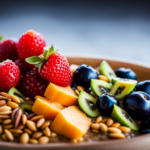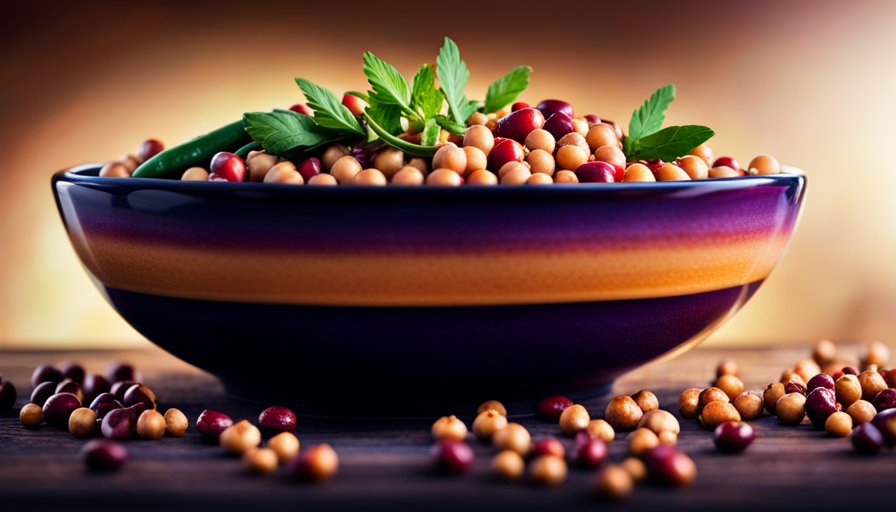In other words, what you consume has a direct impact on your health. Including raw foods in your diet is crucial for improving overall well-being and vitality.
One powerful ingredient that can take your raw food journey to the next level is shatavari. This ancient herb, known for its healing properties, has been used for centuries to support overall vitality and balance.
In this article, I’ll guide you on how to incorporate shatavari into your daily routine in order to maximize its benefits. From boosting immunity and balancing hormones to harnessing its antioxidant and anti-inflammatory effects, shatavari has a lot to offer.
So, if you’re ready to unlock the potential of this incredible herb and enhance your raw food lifestyle, let’s dive in and discover the wonders of shatavari together.
Key Takeaways
- Incorporating raw food into a lifestyle can have numerous health benefits, including improved digestion, mental health, nutrient density, hydration, and weight management.
- Shatavari, an ancient herb, offers healing properties such as boosting immunity, regulating hormones, providing antioxidant and anti-inflammatory effects, and relieving stress.
- Consulting a healthcare professional is essential before adding shatavari to a regimen, as they can provide personalized dosage recommendations based on individual needs.
- Shatavari can be incorporated into daily routines by adding it to smoothies, teas, or meals, and it is available in different forms such as powder, capsules, tea, or tincture.
The Benefits of Shatavari for Overall Health and Well-being
Discover how taking Shatavari can transform your overall health and well-being, leaving you feeling revitalized and empowered. Shatavari, also known as Asparagus racemosus, is an herb that’s been used for centuries in Ayurvedic medicine for its healing properties.
This powerful herb is known for its ability to promote hormonal balance, improve digestion, boost immunity, and support reproductive health. Incorporating Shatavari into your daily routine can have numerous benefits for your physical and emotional well-being.
Shatavari is believed to have adaptogenic properties, meaning it helps the body adapt to stress and maintain homeostasis. It can aid in relieving symptoms of stress, anxiety, and fatigue, allowing you to feel more balanced and energized. Additionally, Shatavari is known for its ability to support female reproductive health by regulating menstrual cycles, reducing symptoms of menopause, and enhancing fertility.
To incorporate Shatavari into your routine, you can take it in various forms such as capsules, powders, or tinctures. It’s recommended to start with a low dosage and gradually increase it to find the right amount for your body. As with any supplement, it’s important to consult with a healthcare professional before adding Shatavari to your regimen, especially if you have any underlying health conditions or are taking medications.
Understanding the power of raw food in promoting wellness, let’s explore the benefits of incorporating a raw food diet into your lifestyle.
Understanding the Power of Raw Food in Promoting Wellness
Explore the incredible potential of consuming unprocessed nourishment to enhance your well-being, and let it be the cherry on top of your health journey. Raw food has been gaining popularity for its numerous benefits, and it’s not hard to see why. Here are a few reasons why incorporating raw food into your diet can have a positive impact on your overall wellness:
-
Enzymes: Raw food is rich in enzymes, which play a crucial role in digestion. These enzymes help break down the food we eat, making it easier for our bodies to absorb nutrients and maintain optimal function.
-
Mental Health: Studies have shown that a diet rich in raw fruits and vegetables can have a positive impact on mental health. The nutrients found in raw food, such as vitamins, minerals, and antioxidants, support brain health and can help improve mood and cognitive function.
-
Nutrient Density: Raw food is packed with essential nutrients, as it hasn’t been subjected to high heat or processing that can degrade these valuable compounds. By consuming raw food, you ensure that you’re getting the maximum amount of nutrients from your meals.
-
Hydration: Raw fruits and vegetables have high water content, which can help keep you hydrated throughout the day. Staying hydrated is essential for overall health, as it supports digestion, circulation, and detoxification.
-
Weight Management: Raw food is typically lower in calories and higher in fiber compared to processed or cooked food. This can help with weight management by promoting feelings of fullness and reducing the likelihood of overeating.
As we delve into exploring the healing properties of shatavari, it’s important to recognize the impact that raw food can have on our well-being.
Exploring the Healing Properties of Shatavari
Shatavari, with its remarkable healing properties, offers a fascinating glimpse into the potential of natural remedies for enhancing overall well-being. This powerful herb, also known as Asparagus racemosus, has been used for centuries in Ayurvedic medicine to promote vitality and balance within the body. The healing benefits of shatavari are numerous, making it a valuable addition to any wellness routine.
One of the key healing benefits of shatavari is its ability to support reproductive health in both men and women. It is known to regulate hormonal imbalances, improve fertility, and alleviate symptoms of menopause. Additionally, shatavari has been found to have anti-inflammatory and antioxidant properties, which can help reduce inflammation and protect against oxidative stress.
When it comes to dosage recommendations, it is important to consult with a healthcare professional or Ayurvedic practitioner. They will be able to provide personalized guidance based on your specific needs and health conditions. In general, shatavari is available in various forms such as powder, capsules, or liquid extract. Starting with a low dosage and gradually increasing it is recommended to assess your body’s response and tolerance.
Incorporating shatavari into your daily routine can be as simple as adding it to your morning smoothie, tea, or even your meals. Its versatility allows for easy integration into various recipes. By incorporating this powerful herb into your daily routine, you can experience the potential healing benefits it offers and enhance your overall well-being.
Next, let’s explore the practical ways of incorporating shatavari into your daily routine, so you can start reaping its benefits effortlessly.
Incorporating Shatavari into Your Daily Routine
To effortlessly incorporate the healing properties of shatavari into your daily routine, try adding it to your favorite smoothie or tea for a nourishing boost of vitality and balance. Shatavari, known for its adaptogenic and rejuvenating qualities, can help support overall well-being and promote a healthy hormonal balance. By incorporating shatavari into your smoothies, you can easily reap its benefits.
To include shatavari in your smoothie, simply add a teaspoon or two of shatavari powder to your blender along with your usual ingredients. You can also combine it with other superfoods like maca or ashwagandha for an extra energy boost. Shatavari not only adds a mild, earthy flavor to your smoothie but also provides a natural energy boost that can help you stay focused and productive throughout the day.
In addition to smoothies, you can also incorporate shatavari into your daily routine by adding it to your favorite tea. Simply steep a teaspoon of shatavari root powder in hot water for a few minutes, strain, and enjoy. This soothing and nourishing beverage can provide a calming effect while also supporting your overall vitality.
In the subsequent section, we’ll explore the different forms of shatavari and how to use them in your daily routine for maximum benefit.
The Different Forms of Shatavari and How to Use Them
Discover the various forms of shatavari and unlock their transformative potential in your daily routine. Shatavari, also known as Asparagus racemosus, is a versatile herb that can be consumed in different forms to reap its numerous health benefits.
Here are five ways you can incorporate shatavari into your daily routine:
-
Powder: Shatavari powder is a popular choice as it can be easily mixed into smoothies, juices, or even sprinkled over your meals.
-
Capsules: If you prefer a more convenient option, shatavari capsules are readily available. Simply follow the dosage recommendations on the packaging.
-
Tea: Enjoy a warm cup of shatavari tea by steeping the dried root in hot water for about 10 minutes. Add honey or lemon for extra flavor.
-
Tincture: Shatavari tincture is a concentrated liquid extract that can be taken directly or added to beverages.
-
Fresh Root: For those who prefer a more natural approach, you can consume shatavari in its fresh root form. Simply peel and chew on the root or add it to your favorite dishes.
Incorporating shatavari into your daily routine can have a positive impact on your overall well-being.
Next, we’ll explore how shatavari can enhance digestion and gut health.
Enhancing Digestion and Gut Health with Shatavari
Improve your digestion and gut health by incorporating this versatile herb into your daily routine, unlocking a world of transformative benefits. Shatavari, a powerful adaptogen, has been used for centuries in Ayurvedic medicine to support digestive health and promote optimal gut function. Its unique properties make it an excellent choice for enhancing gut health and improving digestion.
Shatavari works by soothing the digestive system and reducing inflammation, which can help alleviate symptoms such as bloating, gas, and indigestion. It also helps to strengthen the digestive fire, known as agni, which is essential for proper digestion and nutrient absorption.
To incorporate shatavari into your routine, you can choose from various forms such as powder, capsules, or liquid extract. Each form has its benefits, and it’s important to find the one that suits your needs best. Here is a comparison of the different forms of shatavari:
| Form | Benefits |
|---|---|
| Powder | Easy to mix into smoothies or beverages |
| Capsules | Convenient and easy to take on the go |
| Liquid Extract | Fast-acting and easily absorbed |
By incorporating shatavari into your daily routine, you can enhance your gut health and improve digestion, leading to increased energy and overall well-being. Boosting your immunity and vitality with shatavari is the next step in harnessing the full potential of this incredible herb.
Boosting Immunity and Vitality with Shatavari
As we discussed earlier, Shatavari is a powerful herb that can enhance digestion and promote gut health. But it doesn’t stop there! Shatavari is also known for its ability to boost immunity and vitality, making it a fantastic addition to your daily routine.
When it comes to immunity, Shatavari works by strengthening the body’s natural defense mechanisms. It contains antioxidants that help fight off harmful free radicals, reducing the risk of infections and illnesses. Additionally, Shatavari has adaptogenic properties, which means it helps the body adapt to stress and maintain optimal energy levels. This can be particularly beneficial during times of physical or mental exertion when our immune system may be compromised.
Furthermore, Shatavari has been traditionally used to improve fertility and reproductive health. It is known to support the female reproductive system by balancing hormones and regulating menstrual cycles. This can be especially helpful for women who are trying to conceive or experiencing hormonal imbalances.
By incorporating Shatavari into your daily routine, you can boost your energy levels, improve your immunity, and support your reproductive health. Now, let’s delve into how Shatavari can help balance hormones and support women’s health.
Balancing Hormones and Supporting Women’s Health with Shatavari
Enhancing overall well-being and optimizing hormonal balance, Shatavari proves to be a game-changer for women’s health. Balancing hormones is crucial for women, as imbalances can lead to various health issues. Shatavari, an adaptogenic herb, has been used for centuries in Ayurvedic medicine to promote hormonal balance and improve fertility.
One of the main benefits of Shatavari is its ability to regulate estrogen levels. Estrogen plays a vital role in women’s health, affecting everything from menstrual cycles to mood. By balancing estrogen levels, Shatavari can help alleviate symptoms of hormonal imbalances, such as irregular periods, mood swings, and hot flashes.
In addition to balancing hormones, Shatavari also supports women’s reproductive health. It is known to improve fertility by nourishing the reproductive organs and enhancing the quality and quantity of cervical mucus. This can increase the chances of conception for women trying to get pregnant.
Furthermore, Shatavari has been shown to have antioxidant and anti-inflammatory effects. These properties can help reduce inflammation in the body, which is often a contributing factor to hormonal imbalances. By harnessing the antioxidant and anti-inflammatory effects of Shatavari, women can further support their hormonal balance and overall well-being.
In the next section, we’ll explore how to harness these powerful effects of Shatavari and incorporate it into our daily routine.
Harnessing the Antioxidant and Anti-inflammatory Effects of Shatavari
Unlock the secret to a harmonious internal symphony by tapping into the antioxidant and anti-inflammatory powers of the mystical Shatavari plant. Shatavari, also known as Asparagus racemosus, has been used for centuries in Ayurvedic medicine to support women’s health and hormonal balance.
But did you know that this powerful herb also possesses potent antioxidant properties and anti-inflammatory effects?
Antioxidants are substances that help protect our cells from damage caused by free radicals, which are unstable molecules that can lead to oxidative stress and chronic diseases. Shatavari contains phytochemicals such as saponins and flavonoids, which act as antioxidants in the body. These compounds have been shown to neutralize free radicals and reduce oxidative stress, thus promoting overall health and well-being.
Additionally, Shatavari exhibits strong anti-inflammatory effects. Chronic inflammation is a common underlying factor in many diseases, including autoimmune disorders, cardiovascular diseases, and even cancer. The anti-inflammatory properties of Shatavari may help reduce inflammation in the body, supporting a healthy immune system and reducing the risk of chronic diseases.
To maximize the benefits of Shatavari in your raw food lifestyle, it’s important to ensure that you’re consuming it in the right form and dosage. Stay tuned for the next section, where I’ll share tips and tricks for incorporating Shatavari into your daily routine and getting the most out of this incredible plant.
Tips and Tricks for Maximizing the Benefits of Shatavari in Your Raw Food Lifestyle
After learning about the antioxidant and anti-inflammatory effects of Shatavari, I’m excited to share some tips and tricks for maximizing the benefits of this incredible herb in your raw food lifestyle. As someone who’s incorporated Shatavari into my own routine, I can vouch for its ability to boost energy levels and support overall well-being.
To ensure you’re getting the most out of Shatavari, try these strategies:
-
Experiment with recipes: Add Shatavari powder to your favorite smoothies, raw desserts, or energy balls for a delicious and nutritious boost.
-
Combine with other superfoods: Pair Shatavari with other powerful herbs like Ashwagandha or Maca to create a synergistic effect and enhance its benefits.
-
Start with small doses: Begin with a low dose of Shatavari and gradually increase it to find your optimal dosage. This allows your body to adjust and ensures maximum effectiveness.
-
Listen to your body: Pay attention to how Shatavari makes you feel. If you notice any discomfort or side effects, adjust the dosage or consult a healthcare professional.
By incorporating Shatavari into your raw food lifestyle and following these tips, you can maximize its energy-boosting properties and reap its many benefits. So go ahead and get creative with your recipes, and enjoy the vitality that Shatavari brings to your life.
Frequently Asked Questions
Is Shatavari safe for pregnant women to consume?
Shatavari is generally considered safe for pregnant women to consume. It’s known for its numerous benefits, such as supporting reproductive health and balancing hormones. However, it’s important to consult with a healthcare professional before taking any supplements during pregnancy. The recommended dosage of shatavari varies depending on the form (powder, capsules, etc.) and individual needs. It’s best to follow the instructions provided by the manufacturer or seek guidance from a healthcare practitioner.
Can Shatavari be used as a natural remedy for menopause symptoms?
Yes, shatavari can be used as a natural remedy for menopause symptoms. It’s believed to help balance hormone levels and reduce hot flashes, mood swings, and vaginal dryness. Shatavari is rich in phytoestrogens, which mimic the effects of estrogen in the body. This can provide relief from menopause symptoms without the potential risks associated with hormone replacement therapy. Incorporating shatavari into your daily routine may offer natural alternatives for managing menopause symptoms.
How long does it take to see the effects of Shatavari on hormone balance?
To see the effects of shatavari on hormone balance, it’s important to incorporate it into your daily routine consistently. Shatavari has been shown to have numerous benefits for women’s health, including supporting hormone balance. However, the time it takes to see results may vary for each individual. It’s recommended to consult with a healthcare professional to determine the appropriate dosage and duration for your specific needs.
Are there any potential side effects or interactions with medications when using Shatavari?
There may be potential drug interactions and common side effects when using shatavari. It’s important to consult with a healthcare professional before taking shatavari, especially if you’re currently taking medications. Shatavari may interact with certain medications, such as blood thinners or hormone therapies.
Common side effects of shatavari may include digestive issues, such as bloating or diarrhea. It’s always best to seek professional advice to ensure your safety and well-being.
Can Shatavari help with fertility issues in both men and women?
Shatavari has been traditionally used for centuries to support male and female reproductive health. It’s believed to enhance fertility in both men and women. Shatavari for male infertility may help improve sperm quality and quantity.
For women, it’s thought to regulate hormonal imbalances and support the proper functioning of the female reproductive system. While more research is needed to confirm these claims, incorporating shatavari into a balanced lifestyle may be beneficial for fertility issues.
What Are the Risks and Rewards of Including Shatavari in a Raw Food Diet for Pets?
Including Shatavari in a raw pet food diet poses potential raw pet food risks. While this herb may offer health benefits for pets, it could also cause adverse reactions or interactions with other dietary components. It’s crucial to consult a vet before incorporating Shatavari into a pet’s raw food diet.
Conclusion
In conclusion, incorporating Shatavari into my daily routine has been a game-changer for my overall health and well-being. It’s healing properties have truly amazed me, from boosting my immunity and vitality to balancing my hormones and supporting women’s health.
The antioxidant and anti-inflammatory effects of Shatavari have also had a profound impact on my body. I can’t recommend it enough for anyone looking to maximize the benefits of a raw food lifestyle. Give it a try and experience the incredible coincidences it brings to your health journey.

















